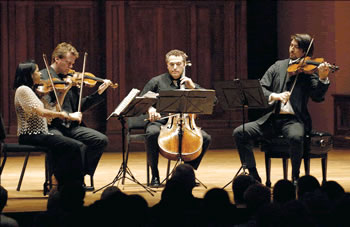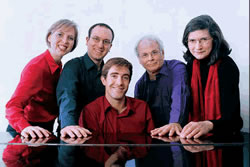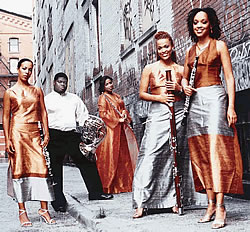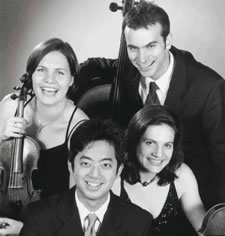
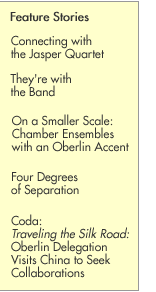 |
|
Home :: Features :: On A Smaller Scale On a Smaller Scale: Chamber Ensembles with an Oberlin Accent
When violinist Simin Ganatra ’96 arrived at Oberlin in the early 1990s, a veteran of many summer chamber music camps, she was determined that some day she would have her own string quartet. Joshua Gindele ’97, who entered the Conservatory at around the same time, wasn’t sure he wanted a career in music; he chose Oberlin so that he could experiment and play tennis in addition to the cello. Today, both are members of highly successful string quartets. Ganatra is first violinist of the Pacifica Quartet, and Gindele is the cellist of the Miró Quartet. Both groups were launched when their members were Oberlin students, and each still has a second Oberlin member, violinist Sibbi Bernhardsson ’95 in the Pacifica and violinist Daniel Ching ’95 in the Miró. String players do not represent the only success stories—the sextet eighth blackbird, now celebrating its 10th anniversary, began as a project of Oberlin’s Contemporary Music Ensemble at around the same time. These three ensembles have collected most of the major chamber music awards, winning such competitions as the Coleman, Fischoff, Banff, Naumberg, and the Cleveland Quartet Award. All have busy touring schedules and hold academic residencies. Members of the Pacifica, the Miró, and eighth blackbird knew each other, played together, and even lived together when they were students, and their formative years are a microcosm of the spontaneous vitality of the Oberlin chamber music scene. Gindele, a student of Professor of Cello Peter Rejto, remembers, “Everyone wanted to play chamber music, and we were feeding off each other’s energies and playing together.” Ching adds: “There was a lot of excitement about playing chamber music, which stemmed from the fact that the students got along.” The three groups still get along. When Nicholas Photinos ’96, cellist of eighth blackbird, got married last June, the Pacifica and Miró Quartets played the Mendelssohn Octet at his wedding.
Oberlin has always produced chamber musicians. Flutist Patricia Spencer ’65 is a founding member of the Da Capo Chamber Players; pianist Blair McMillen ’93 and violinist David Bowlin ’00 are recent Da Capo additions. Violinist Ronald Copes ’71 is a member of the Juilliard String Quartet, and the late Robert Koff ’41 was that ensemble’s founding violinist. Horn player Greg Miller ’87 was a longtime member of the Empire Brass Quintet. Oberlin Professor of Violin Gregory Fulkerson ’71 was a founding member of the Audubon Quartet and is now the first violinist of the newly formed faculty ensemble, the Oberlin String Quartet. Assistant Professor of Cello Darrett Adkins ’91, also of the Oberlin String Quartet, was until 2000 a member of the Flux Quartet. Violist Kirsten Docter ’92 joined the well-established Cavani Quartet a year after graduation. The tradition continues. Violist Elizabeth Freivogel ’00 is a member of the Jupiter Quartet, which won the Fischoff and Banff competitions and has just been named to the Young Concert Artists roster. And there are many others.
Dean of the Conservatory David H. Stull explains that the atmosphere at Oberlin fosters such ensembles and players. “Oberlin focuses on students becoming highly motivated to be engaged in their careers, and they are most engaged when they are in chamber music,” he says. “The culture here encourages students who have pioneering spirits. They are interested in small groups, in making music outside of traditional groups.” Chamber music, he says, is an important facet of the Oberlin experience, not simply for itself, but for the wide range of skills it teaches; Oberlin faculty members strongly believe in the chamber music core. “It is a vehicle through which you become a great ensemble player. It’s how people acquire the skills of how to listen, play, and absorb the broader meaning of a piece. Without a conductor, the student is more involved in the creation of the piece.” The lively chamber music environment at Oberlin is thus perpetuated by student enthusiasm. “The culture has grown up that way,” Stull says. “In some ways, it’s purposeful, through curriculum, but it is also attributable to great invention, dedication, and good fortune.” Indeed, many generations of Oberlin-trained musicians believe Oberlin was critical in their choice to pursue chamber music careers. The Conservatory requires its students to take six semesters of chamber music, but many do a great deal more. Daniel Ching, already a chamber music enthusiast when he arrived at Oberlin from San Francisco, declares, “I was Mr. Chamber Music. After winter term of my freshman year, I was in four or five groups each semester. Anytime someone asked, I always said, ‘Sure, I can squeeze in a rehearsal between 11 p.m. and 1 a.m.’ or ‘I’ve always wanted to play that piece.’” Though he was playing and practicing around the clock, Ching says he was often so busy with chamber music that his teachers despaired. Now a teacher himself—the Miró has a faculty residency at the University of Texas at Austin—Ching urges his students not to neglect their solo pieces, but says he has no regrets. Blair McMillen thinks the Oberlin student population itself is conducive to the pursuit of chamber music. “It’s a diverse, intelligent, and interesting student body,” he says. “The students come from all over, and they want to participate in as many different musical experiences as they can. I think flexibility and open-mindedness to experience are what separates Oberlin from other music schools, where singular musical pursuits are often emphasized.” Oberlin alumni also cite the friendly atmosphere on campus. “Chamber music is a social activity, and students do it because they want to,” says Darrett Adkins. “I have students who sight read together every week.” Simin Ganatra recalls a mutually supportive rather than competitive atmosphere among the students. “People attended everyone else’s recitals,” she says. “Sibbi and I attended recitals twice a week and they were packed.”
Toyin Spellman ’94, oboist of Imani Winds, a quintet that also includes a second Oberlin grad, bassoonist Monica Ellis ’95, chose Oberlin because “it was an open and friendly place, and it seemed like a perfect match for my personality.” Spellman, who played in six chamber music groups her senior year, would corral her friends and bring them along to her lessons with Professor of Oboe James Caldwell. “I’m a friendly person,” she says. “I knew everyone in the Con.” After graduation, she was heading toward an orchestra career, but soon realized that it wasn’t making her happy. “I wanted to be more in charge of my life, and part of that feeling came from Oberlin.”
Location, Location, Location Oberlin’s secluded locale is also ideal for chamber music. Says Adkins, “The town of Oberlin is small and contained, and everyone knows everyone. This makes for a really fertile environment.” Chamber music ensembles need time and space to develop, he says, and the Oberlin milieu can afford that. “At conservatories like Juilliard [where Adkins also teaches], lots of opportunities are quasi-professional in nature, and the demands of the city are such that student chamber music doesn’t get that kind of focused, quiet, meditative attention that it gets at Oberlin.”
The small-town atmosphere and residential, full-time faculty leads to closer ties between students and faculty. Pianist of eighth blackbird Lisa Kaplan ’96 says, “Since town and campus are one and the same, you can’t help but bump into your professors at the bookstore. It seemed like a community.” Faculty members’ collegiality made a big impression on violinist Rebecca McFaul ’93, now a member of the Fry Street Quartet, which is in residence at Utah State University and which won the Millennium Grand Prize at the 2000 Fischoff Competition. McFaul, who cites Professors of Violin Marilyn McDonald and Gregory Fulkerson and former Oberlin faculty members Jeffrey Irvine and Norman Fisher as important mentors, says, “Faculty collegiality fosters chamber music and promotes collaboration among students in a wonderful way.” The Oberlin String Quartet, which includes Assistant Professor of Violin Kyung Sun Lee and Professor of Viola Peter Slowik as well as Adkins and Fulkerson, is a concrete demonstration of faculty collegiality in the service of great repertoire. With six required semesters of chamber music, to say nothing of the additional chamber projects that students generate, Oberlin faculty members do a great deal of coaching every semester. “We hire string faculty who are interested in chamber music,” says Fulkerson, who is currently coaching three groups. According to the Miró players, Fulkerson’s coaching and support was critical to them. “He believed in the group and he pushed us,” Ching says. “He also opened our eyes to the mechanics of playing instruments as a quartet. He’s so analytical. He has everything worked out, like how many hours it takes to learn a particular piece, or how to use the bow to get exactly the right effect. When you’re young, you just want to make it exciting, but he gave us the technical ability to get things to match and to make the sound cohesive. It’s the foundation for our technique.” |
